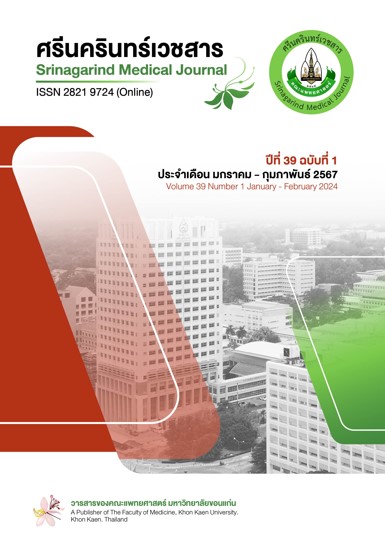ภาวะโภชนาการโดยเกณฑ์น้ำหนักต่อส่วนสูงและดัชนีมวลกายในเด็กที่มีภาวะปากแหว่งเพดานโหว่ช่วงอายุ 2 ถึง 5 ปี
คำสำคัญ:
ภาวะโภชนาการ, เด็ก, ปากแหว่งเพดานโหว่บทคัดย่อ
หลักการและวัตถุประสงค์ :ผู้ป่วยปากแหว่งเพดานโหว่มีปัจจัยเสี่ยงต่อการขาดสารอาหารเนื่องจากปัญหาในการดูดและการกลืนส่งผลต่อภาวะโภชนาการ การผ่าตัดอาจทำให้การดูดกลืนดีขึ้นได้รับอาหารที่มากขึ้น ซึ่งแต่การประเมินภาวะโภชนาการด้วยเกณฑ์มาตรฐานจะช่วยให้ได้ข้อมูลที่ชัดเจนในการวางแผนดูแลภาวะโภชนาการในเด็กปากแหว่งเพดานโหว่ การศึกษาครั้งนี้จึงมีวัตถุประสงค์เพื่อศึกษาและเปรียบเทียบภาวะโภชนาการของเด็กปากแหว่งเพดานโหว่ด้วยเกณฑ์น้ำหนักต่อส่วนสูงและดัชนีมวลกาย
วิธีการศึกษา: เป็นการศึกษาเชิงพรรณนาแบบย้อนหลัง รวบรวมข้อมูลที่มีอยู่เดิม (retrospective descriptive study) โดยกลุ่มประชากรเป็นเด็กที่มีภาวะปากแหว่งเพดานโหว่ของศูนย์ตะวันฉายในระหว่างปี พ.ศ. 2559 – 2563 ที่มีช่วงอายุ 2 ถึง 5 ปี เกณฑ์ประเมินภาวะโภชนาการใช้เกณฑ์น้ำหนักต่อส่วนสูงและดัชนีมวลกาย
ผลการศึกษา: จำนวนกลุ่มตัวอย่างทั้งสิ้น 96 ราย เมื่อใช้เกณฑ์น้ำหนักต่อส่วนสูงประเมินภาวะโภชนาการพบว่า กลุ่มตัวอย่างมีน้ำหนักต่ำกว่าเกณฑ์ น้ำหนักปกติ และน้ำหนักเกินเกณฑ์ ร้อยละ 20.80, 76.00 และ 3.10 ตามลำดับ โดยไม่พบภาวะอ้วน แต่หากใช้เกณฑ์ดัชนีมวลกาย พบว่า กลุ่มตัวอย่างมีน้ำหนักต่ำกว่าเกณฑ์ น้ำหนักปกติ และน้ำหนักเกินเกณฑ์ และภาวะอ้วน ร้อยละ 43.80, 41.70, 11.50 และ 3.10 ตามลำดับ และเมื่อประเมินโดยจำแนกตามเพศ ช่วงอายุและชนิดของปากแหว่งเพดานโหว่พบว่าการประเมินด้วยเกณฑ์น้ำหนักต่อส่วนสูงจะมีน้ำหนักต่ำกว่าเกณฑ์ในจำนวนที่น้อยกว่าการประเมินด้วยดัชนีมวลกาย
สรุป: การประเมินภาวะโภชนาการของเด็กปากแหว่งเพดานโหว่พบว่าการประเมินโดยใช้เกณฑ์น้ำหนักต่อส่วนสูงจะมีน้ำหนักต่ำกว่าเกณฑ์น้อยกว่าการใช้เกณฑ์ดัชนีมวลกาย ทั้งในการประเมินด้วยการจำแนกเพศช่วงอายุและชนิดของปากแหว่งเพดานโหว่
เอกสารอ้างอิง
Felix-Schollaart B, Hoeksma JB, Prahl-Andersen B. Growth comparison between children with cleft lip
and/or palate and controls. Cleft Palate Craniofac J 1992;29(5):475-80. doi: 10.1597/1545-1569_1992_029_0475_gcbcwc_2.3.co_2.
Gopinath VK, Muda WA. Assessment of growth and feeding practices in children with cleft lip and palate. Southeast Asian J Trop Med Public Health 2005;36(1):254-8.
Cunningham ML, Jerome JT. Linear growth characteristics of children with cleft lip and palate. J Pediatr 1997;131(5):707-11. doi: 10.1016/s0022-3476(97)70097-0.
Chowchuen B, Thanaviratananich S, Chichareon V, Kamolnate A, Uewichitrapochana C, Godfrey K. A Multisite Study of Oral Clefts and Associated Abnormalities in Thailand: The Epidemiologic Data. Plast Reconstr Surg Glob Open 2016;3(12):e583. doi: 10.1097/GOX.0000000000000570.
Seth AK, McWilliams BJ. Weight gain in children with cleft palate from birth to two years. Cleft Palate J 1988;25(2):146-50.
Ranalli DN, Mazaheri M. Height-weight growth of cleft children, birth to six years. Cleft Palate J 1975;12(4):400-4.
Barakati SF, Alkofide EA. Growth status of Saudi patients with cleft lip and palate. Saudi Med J 2002;23(7):823-7.
Lee J, Nunn J, Wright C. Height and weight achievement in cleft lip and palate. Arch Dis Child 1997;76(1):70-2. doi: 10.1136/adc.76.1.70a.
Marques IL, Nackashi JA, Borgo HC, Martinelli AP, Pegoraro-Krook MI, Williams WN, et al. Longitudinal study of growth of children with unilateral cleft-lip palate from birth to two years of age. Cleft Palate Craniofac J 2009;46(6):603-9. doi: 10.1597/08-105.1.
Lipman TH, Rezvani I, Mitra A, Mastropieri CJ. Assessment of stature in children with orofacial clefting. MCN Am J Matern Child Nurs1999;24(5):252-6. doi: 10.1097/00005721-199909000-00009.
Montagnoli LC, Barbieri MA, Bettiol H, Marques IL, de Souza L. Growth impairment of children with different types of lip and palate clefts in the first 2 years of life: a cross-sectional study. J Pediatr (Rio J) 2005;81(6):461-5. doi: 10.2223/JPED.1420.
Tienboon P, Wahlqvist ML. A prospective study of weight and height going from infancy to adolescent. Asia Pac j Clin Nutr 2002;11(1):425-47. doi: 10.1046/j.1440-6047.2002.00281.x
Bureau of Nutrition, Department of Health, Ministry of Public Health. Weight Height andNutritional Status Interpretation in 1day – 19 year olds, 1999.
WHO Multicentre Growth Reference Study Group. WHO Child Growth Standards based on length/height, weight and age. Acta Paediatr Suppl 2006;450:76-85. doi: 10.1111/j.1651-2227.2006.tb02378.x.
Ratanachu-ek S,TaveekulP, Eamopas O, Suthutvoravut U, editors. Clinical Practice Guidelines for Obesity Prevention and Treatment in Children 2014. Society of pediatric Nutrition of Thailand and the Royal College of pediatricians of Thailand; 2014.
Mo-Suwan L. Child Health. In: Aekplakorn W, editor. The report of Thailand population health examination survey IV 2008-9. National Health Examination Survey Office. Nonthaburi: The Graphico systems co., Ltd; 2011:103-25.
Zarate YA, Martin LJ, Hopkin RJ, Bender PL, Zhang X, Saal HM. Evaluation of growth in patients with isolated cleft lip and/or cleft palate. Pediatrics 2010;125(3):e543-9. doi: 10.1542/peds.2009-1656.
ดาวน์โหลด
เผยแพร่แล้ว
รูปแบบการอ้างอิง
ฉบับ
ประเภทบทความ
สัญญาอนุญาต
ลิขสิทธิ์ (c) 2024 ศรีนครินทร์เวชสาร

อนุญาตภายใต้เงื่อนไข Creative Commons Attribution-NonCommercial-NoDerivatives 4.0 International License.




